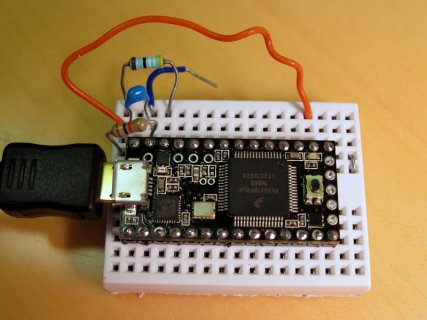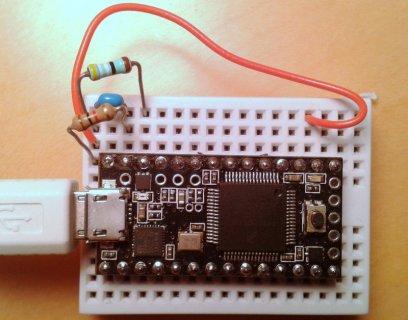// Analog input test for Teensy 3.0 Oct 4 2012 - Feb 26 2014 J.Beale
// Setup: https://picasaweb.google.com/109928236040342205185/Electronics#5795546092126071650
#define VREF (3.266) // ADC reference voltage (= power supply)
#define VINPUT (2.176) // ADC input voltage from resistive divider to VREF
#define ADCMAX (65535) // maximum possible reading from ADC
#define EXPECTED (ADCMAX*(VINPUT/VREF)) // expected ADC reading
#define SAMPLES (10000) // how many samples to combine for pp, std.dev statistics
const int analogInPin = A0; // Analog input is AIN0 (Teensy3 pin 14, next to LED)
const int LED1 = 13; // output LED connected on Arduino digital pin 13
int sensorValue = 0; // value read from the ADC input
long oldT;
void setup() { // ==============================================================
pinMode(LED1,OUTPUT); // enable digital output for turning on LED indicator
analogReference(EXTERNAL); // set analog reference to internal ref
analogReadRes(16); // Teensy 3.0: set ADC resolution to this many bits
analogReadAveraging(16); // average this many readings
Serial.begin(115200); // baud rate is ignored with Teensy USB ACM i/o
digitalWrite(LED1,HIGH); delay(1000); // LED on for 1 second
digitalWrite(LED1,LOW); delay(3000); // wait for slow human to get serial capture running
Serial.println("# Teensy 3.0 ADC test start: ");
} // ==== end setup() ===========
void loop() { // ================================================================
long datSum = 0; // reset our accumulated sum of input values to zero
int sMax = 0;
int sMin = 65535;
long n; // count of how many readings so far
double x,mean,delta,sumsq,m2,variance,stdev; // to calculate standard deviation
oldT = millis(); // record start time in milliseconds
sumsq = 0; // initialize running squared sum of differences
n = 0; // have not made any ADC readings yet
mean = 0; // start off with running mean at zero
m2 = 0;
for (int i=0;i<SAMPLES;i++) {
x = analogRead(analogInPin);
datSum += x;
if (x > sMax) sMax = x;
if (x < sMin) sMin = x;
// from http://en.wikipedia.org/wiki/Algorithms_for_calculating_variance
n++;
delta = x - mean;
mean += delta/n;
m2 += (delta * (x - mean));
}
variance = m2/(n-1); // (n-1):Sample Variance (n): Population Variance
stdev = sqrt(variance); // Calculate standard deviation
Serial.print("# Samples/sec: ");
long durT = millis() - oldT;
float datAvg = (1.0*datSum)/n;
Serial.print((1000.0*n/durT),2);
Serial.print(" Avg: "); Serial.print(datAvg,2);
Serial.print(" Offset: "); Serial.print(datAvg - EXPECTED,2);
Serial.print(" P-P noise: "); Serial.print(sMax-sMin);
Serial.print(" St.Dev: "); Serial.println(stdev,3);
} // end main() =====================================================



